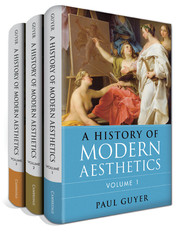Book contents
- Volume 1 The Eighteenth Century
- Frontmatter
- Epigraph
- Contents
- Acknowledgments
- Introduction
- 1 Prologue
- Part One Aesthetics in Britain, 1725–1800
- Part Two French Aesthetics in Mid-Century
- Part Three German Aesthetics between Wolff and Kant
- 6 The First Generation of Wolffian Aesthetics
- 7 German Aesthetics at Mid-Century
- 8 Breaking with Rationalism
- Part Four Kant and After
- Bibliography
- Index
- Volume 2 The Nineteenth Century
- Volume 3 The Twentieth Century
- References
8 - Breaking with Rationalism
From Herder to Moritz
from Part Three - German Aesthetics between Wolff and Kant
Published online by Cambridge University Press: 05 June 2015
- Volume 1 The Eighteenth Century
- Frontmatter
- Epigraph
- Contents
- Acknowledgments
- Introduction
- 1 Prologue
- Part One Aesthetics in Britain, 1725–1800
- Part Two French Aesthetics in Mid-Century
- Part Three German Aesthetics between Wolff and Kant
- 6 The First Generation of Wolffian Aesthetics
- 7 German Aesthetics at Mid-Century
- 8 Breaking with Rationalism
- Part Four Kant and After
- Bibliography
- Index
- Volume 2 The Nineteenth Century
- Volume 3 The Twentieth Century
- References
Summary
The period from the late 1760s to the late 1780s, thus the two decades preceding the publication of Kant’s Critique of the Power of Judgment in the 1790s, saw an increasing eclecticism in German aesthetics, as the grip of Wolffian rationalism was – at least temporarily – loosened, and new concepts or at least new emphases were introduced into German aesthetic discourse. Some would argue that the 1762 Aesthetica in nuce of Johann Georg Hamann (1730–1788), a fellow Königsberger and early friend of Kant who took a radical turn toward mysticism, is the start of a fundamentally new movement in German aesthetics, a synthesis of an emphasis on the subjectivity of genius that points toward Sturm und Drang and later Romanticism on the one hand and on art as a vehicle of truth, ultimately of theological truth, on the other, that points toward the cognitivist aesthetics of German Idealism. The rhapsodic prose of Aesthetica in nuce is hard to fit into any philosophical tradition, even by the somewhat relaxed standards of much of what has been here treated as philosophical aesthetics, and this chapter instead begins with a discussion of some of the early work of Johann Gottfried Herder, who, though himself certainly capable of rhapsodic prose, remained more closely engaged with the mainstream of eighteenth-century aesthetics than did Hamann; indeed, one of Herder’s earliest preserved essays is a “Monument to Baumgarten.” In that essay, Herder also praised Mendelssohn, and one theme in his early work in aesthetics can be considered the development of Mendelssohn’s recognition of the rôle of the body and the senses as embodied in aesthetic experience.
- Type
- Chapter
- Information
- A History of Modern Aesthetics , pp. 377 - 418Publisher: Cambridge University PressPrint publication year: 2014



